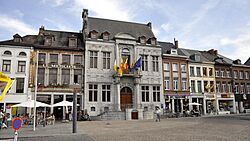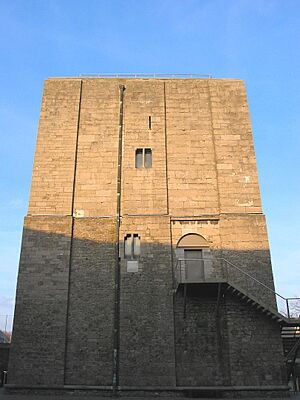Ath facts for kids
Quick facts for kids
Ath
Ât (Picard)
Aat (Dutch)
|
|||
|---|---|---|---|

Ath City Hall
|
|||
|
|||
| Country | Belgium | ||
| Community | French Community | ||
| Region | Wallonia | ||
| Province | Hainaut | ||
| Arrondissement | Ath | ||
| Area | |||
| • Total | 126.95 km2 (49.02 sq mi) | ||
| Population
(2018-01-01)Lua error in Module:Wd at line 1575: attempt to index field 'wikibase' (a nil value).
|
|||
| • Total | Lua error in Module:Wd at line 1,575: attempt to index field 'wikibase' (a nil value). | ||
| Postal codes |
7800, 7801, 7802, 7803, 7804,
7810, 7811, 7812, 7822, 7823 |
||
| Area codes | 068 | ||
| Website | www.ath.be | ||
Ath is a city and municipality in Wallonia, a region of Belgium. It is located in the province of Hainaut.
The municipality of Ath includes several smaller towns and villages. These are Arbre, Ath, Bouvignies, Ghislenghien, Gibecq, Houtaing, Irchonwelz, Isières, Lanquesaint, Ligne, Maffle, Mainvault, Meslin-l'Évêque, Moulbaix, Ormeignies, Ostiches, Rebaix, Villers-Notre-Dame, and Villers-Saint-Amand.
Ath is famous as the "City of Giants." This nickname comes from the Ducasse d'Ath festival. This special event happens every year in late August. During the festival, huge figures of characters like Goliath and Samson are paraded through the streets. People also act out Goliath's wedding and his famous fight with David.
The city of Ath is also where the Dender river begins. It forms when its eastern and western branches join together here.
Contents
History of Ath: A Journey Through Time
Early Days: Before the 1500s
Long ago, in Gallo-Roman times, there were small settlements in the Ath area. But the city of Ath really started around the year 1160. That's when Count Baudouin IV of Hainaut bought some land.
A few years later, Count Baudouin built the Burbant Tower. You can still see this tower today! It was built to protect his new land. Soon, Ath became a city with special rights. In 1325, a market hall was built on the Grand-Place. This helped the city grow and attract more people.
In 1357, an important agreement called the "Peace of Ath" was signed here. It helped end a disagreement about who would rule the Brabant area. By then, Ath's weekly market, held on Thursdays, was very popular. Sellers from far away came to trade.
Ath became known for making linen, cloth, and leather. They also made fancy items like gold jewelry and sculptures. As the city grew, a second wall was built around it by the late 1300s. In 1416, a school for Latin was built. A famous scholar named Justus Lipsius later studied there. At this time, about 5,000 people lived in Ath.
Modern Times: From 1500s to Today
In 1667, the army of Louis XIV of France took over Ath in just one day. Ath then became the first French city in the Spanish Netherlands. Soon after, a famous engineer named Vauban built strong new forts around the city. These forts had eight large sections called bastions.
Ath faced more challenges in 1745 when the French army attacked again. By the late 1700s, about 7,300 people lived in Ath. However, the population went down in the early 1800s.
In 1816, experts decided that Ath's defenses needed to be stronger. The Dutch, under King William I, built the Féron Fort in 1824. This made Ath an important strategic location again.
Later, in 1839, the Treaty of London (1839) was signed. This treaty created the Kingdom of Belgium. Part of the agreement said that the fort in Ath, and others like it, should be taken down.
With the fort gone, the land was free for the town to grow. Between 1850 and 1914, Ath saw a new period of growth. Industries like forestry, farming (breweries and mills), and textile production became very important.
In the 1900s, many of these older industries started to decline. New activities like shopping, government work, and education took their place. In recent years, many parts of the city have been improved. Old buildings and monuments have been fixed up and restored.
What to See in Ath
Ath has many interesting places to visit:
- The Burbant Tower is very old, built in the 12th century. It was named after the nearby Landgraviate of Brabant.
- The town hall building was built in the 17th century.
- The church of Saint Julien was rebuilt after a fire in the 1800s. It still has a Gothic tower and a special chapel. It also has a famous set of bells from the 1500s called a carillon.
- The church of Saint Martin and an outdoor wooden cross sculpture, called a calvary, both date back to the 16th century.
Fun Festivities: The Ducasse
The “Ducasse” is a very old and popular festival in Ath. It started in the 1400s as a yearly parade. This parade celebrated the special day when the local Saint Julien church was made holy. The procession used to show stories from the Old Testament, New Testament, and other old legends.
Today, the “Ducasse” is a huge celebration that lasts for several days. It takes place at the end of August and beginning of September. The most exciting part is the parade of giants, called Cortège des géants in French. The most famous characters are David and Goliath.
In 2008, UNESCO recognized the Ducasse as a "Masterpiece of the Oral and Intangible Heritage of Humanity." This means it's a very important cultural tradition. However, in 2022, it was removed from this list. This happened because of complaints about one of the characters in the parade, which was seen as offensive.
Getting Around: Transportation
Ath is located along the N56 road, which helps people travel to and from the city.
Famous People from Ath
Many interesting people were born in Ath:
- Arnold Caussin, a musician and composer (born around 1510).
- Michael Baius, a theologian (someone who studies religion).
- Julien-Joseph Ducorron, a painter (1770–1848).
- Eugène Defacqz, a politician (1797–1871).
- Jean Taisner, a musician, mathematician, and astrologer (1508-1562).
- Louis Hennepin, a Catholic priest, missionary, and explorer of North America (17th century).
- Fanny Heldy, an opera singer (19th century).
- Joseph Jules Descamps, a politician (1820–1892).
- Ernest F. Cambier, a Belgian explorer (1844–1921).
- Henri Vernes, a novelist (20th century).
- Guy Spitaels, a politician (20th century).
- Olivier Dupuis, a politician (20th century).
- Pierre Descamps, a politician (20th century).
- Anders Tang, a humorist (20th century).
- Julian the Hospitaller, a legendary saint, is believed by some to have been born in Ath.
- Jacques de Saint-Luc, a musician who played the lute and composed music (1616 – c. 1710).
See also
 In Spanish: Ath para niños
In Spanish: Ath para niños






